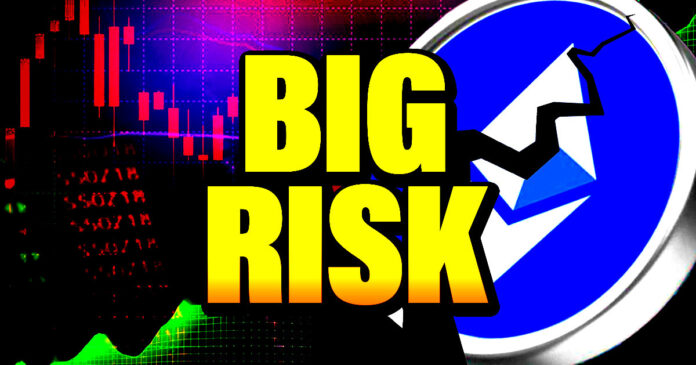Is Ethereum at risk? And if so, why? Ethereum seems to be everyone’s darling. There’s a potential ETH spot ETF coming up. Their Cancun-Deneb or Dencun network upgrade is imminent. This should increase the chains’ scalability. It should also reduce gas fees.
So, all that is good news. Nonetheless, anything about gas fees on Ethereum, files under ‘seeing is believing’. However, that’s not what I want to talk about today. There’s another, much more important, discussion that we should be having about Ethereum. This discussion relates to staking and Ethereum. In other words, staked ETH. It appears that there may be some issues that I want to bring to your attention.
1) Two Issues With Staked ETH
Staking Ethereum is popular. Especially with liquid staking platforms like Lido. This offers two advantages:
- You don’t need to run a node, which requires 32 ETH. That’s a big investment, which most of us can’t afford.
- The liquid staking derivative, you receive, is well, liquid. In other words, you can cash it in for other assets. For example, stablecoins like USDT or USDC.
Liquid staking offers you the option to earn double rewards. That’s also enticing:
- Once for your staked ETH, your principal stake.
- The other rewards come from your LSTs or liquid staking tokens.
With Lido, that’s stETH or with Rocket Pool, it’s rETH. There are plenty more options. However, these two are the best-known LSD platforms. You can use these derivatives in DeFi again. However, when you look at staking Ethereum, there are two potential issues:
- Most of the Ethereum staking pools use only one execution client. More on this shortly.
- The max thresholds for staking protocols.
So, let’s take a closer look at both of them.
2) One Execution Client Staking Pools
Validators usually run two different clients at the same time. These clients are software implementations. You need them to run your node. Here’s why you need them in case you run a node:
- One is for consensus — These clients take part in the consensus process. For example, they validate new blocks. They also propose blocks and agree with other clients.
- One is for execution — They take care of new transactions that are broadcast on the network. In the Ethereum Virtual Machine (EVM) they execute these transactions. As a result, they maintain the state of Ethereum and its database.
dear @coinbase
today, i unstaked all of the ETH i had staked with you since the first day you offered it as a service. i kept it there to earn passive yield, but also to support your work for the crypto industry (which i greatly value)
but i can't ignore the risks of what…
— DCinvestor (@iamDCinvestor) January 22, 2024
So, the execution client appears to be the biggest issue. The reason is that 78% of all node owners use the same client. That’s Geth. You can see that in these stats by ‘clientdiversity‘. With consensus clients, there’s much more diversity. Prysm is the biggest consensus client and has a 38.84% market share. Closely followed by Lighthouse with 33.05%. Here we see improvement in diversity.
The Role Geth Plays
So, let’s get back to the execution clients. If we look at the next site, all validator platforms in red use Geth. As we saw in the previous stats, that adds up to 78%. We see some big staking platforms all using Geth. For example:
- Ankr.
- Blox Staking.
- Binance.
- Bitcoin Suisse.
- Bitfinex.
- Coinbase.
- Kraken.
- Stakefish.
Some good news is that Allnodes already switched to a different client with their staked ETH. However, Lido still uses almost 68% of its nodes with Geth and Rocket Pool at 30%. However, Lido is down from 93% in Q3, 23. With a 78% majority, Geth poses a ‘Super majority client risk’. That’s when more than 2/3 of all validators use the same client software.
So, when I do the math, 78% is well above that threshold. The danger is that Geth can finalize the chain, and it doesn’t need the other chains to agree.
3) The 33%, 51%, and 66% Thresholds
So, there are three different thresholds we need to be aware of:
- 33% threshold — With control of 33% over the blockchain, a bad actor can disrupt the liveness of a network. This is a fundamental security feature. Liveness means that a client can finalize the chain. With such a 33% threshold, you can delay finalizing a chain. However, a bad actor can’t take control of the chain.
This is also the threshold that the Nakamoto Coefficient to measure decentralization uses.
- 51% threshold — Now there’s a theoretical chance that the chain will split, and you will have two chains via a fork. Bad actors can’t take full control over the chain yet. For instance, the remaining good actors can still challenge double-spending and transaction censorship.
- 66% threshold — Now a bad actor has full control over most of the block validation process. For example, he could reverse transactions or start double-spending. This compromises the chains’ security and integrity.
So, this proves that the 78% super majority of Geth is a serious problem. Diversity in execution clients is much needed. This appears to be an underestimated concern. It is time that the Ethereum validators and staking platforms wake up to this. If Geth had a bug, it could be disastrous for the chain. There could be a loss of funds with up to 20% of all ETH, a fork, and Ethereum’s reputation would also suffer.
In case of a supermajority Ethereum client bug that leads to complete loss of the stake of those stakers at the moment this would burn > ~20% of the entire ETH supply.
Do you believe a social consensus soft/hard fork is logical in that case or not? More complicated? Comment 👇
— Lefteris Karapetsas | Hiring for @rotkiapp (@LefterisJP) January 22, 2024
Coinbase’s CEO Brian Armstrong mentioned that he would take a look at the problem. Lido also slowly started to diversify. And that brings me to the maximum thresholds for staking platforms.
4) Max Thresholds for Staking Platforms
We saw that there’s a problem with the execution clients. However, a similar concern runs through the staking platforms. Lido is the biggest platform for staked ETH, and its market share is almost 32%. Remember from a minute ago? Let’s look back at the previous thresholds I mentioned. We learned that 33% is the first critical threshold. Well, Lido is almost at that threshold.
Danny Ryan went even so far as to call Lido ‘a systemic threat to Ethereum’. He’s an Ethereum Foundation researcher. Check out his video interview with him and this post. However, it still would be very difficult to pose a threat with a 33% stake. Lido would need to align all its node operators. That’s around 37 of them. So, that’s not an easy task.
On the other hand, Lido’s governance may pose a bigger threat. All LDO holders can vote, but the majority is in the hands of VCs. That’s a lot of power with only a few shareholders.
So, there’s a lot at stake, pun intended, on the Ethereum chain. We as delegators can do something about and use smaller platforms. Not stake with Lido. Validators can also help by choosing minority clients. Like Allnodes did. However, before these changes, it’s a potential staking bomb that Ethereum sits on.





























